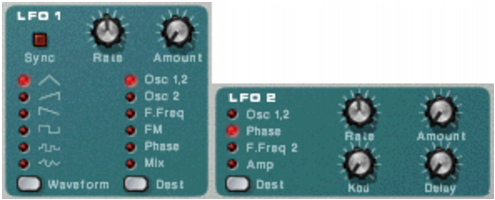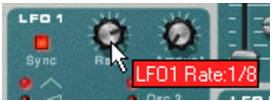LFO stands for Low Frequency Oscillator. LFO’s are oscillators, just like Osc 1 & 2, in that they also generate a waveform and a frequency. However, there are two significant differences:
The most typical application of an LFO is to modulate the pitch of a (sound generating) oscillator, to produce vibrato. Subtractor is equipped with two LFO’s. The parameters and the possible modulation destinations vary somewhat between LFO 1 and LFO 2.
|
| Waveform
|
|||
|
|||
|
|||
By clicking this button you activate/deactivate LFO sync. The frequency of the LFO will then be synchronized to the song tempo, in one of 16 possible time divisions. When sync is activated, the Rate knob (see below) is used for setting the desired time division.
This parameter determines to what degree the selected parameter destination will be affected by LFO 1. Raising this knob’s value creates more drastic results.
LFO 2 is polyphonic. This means that for every note you play, an independent LFO cycle is generated, whereas LFO 1 always modulates the destination parameter using the same “cycle”. This can be used to produce subtle cross-modulation effects, with several LFO cycles that “beat” against each other. This also enables LFO 2 to produce modulation rates that vary across the keyboard (see the “Keyboard Tracking” parameter below).
|
|||
This parameter is used to set a delay between when a note is played and when the LFO modulation “kicks in”. For example, if Osc 1 & 2 is selected as the destination parameter and Delay was set to a moderate value, the sound would start out unmodulated, with the vibrato only setting in if you hold the note(s) long enough. Delayed LFO modulation can be very useful, especially if you are playing musical instrument-like sounds like violin or flute. Naturally it could also be used to control more extreme modulation effects and still retain the “playability” of the sound.
If LFO keyboard tracking is activated, the LFO rate will progressively increase the higher up on the keyboard you play. Raising this value creates more drastic results.
|
|
If the LFO is set to modulate the phase offset, LFO keyboard tracking can produce good results. For example, synth string pads and other sounds that use PWM (see “Phase Offset Modulation”) can benefit from this.
|
This parameter determines to what degree the selected parameter destination will be affected by LFO 2. Raising this knob’s value creates more drastic results.

